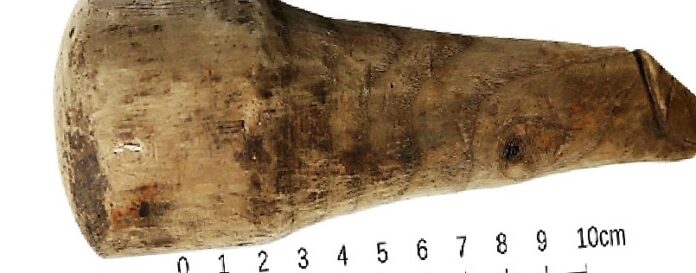The Curious Unveiling
Awe-inspiring discoveries often lie dormant within the ancient remnants of our past, waiting to be unearthed by the tenacious hands of archaeologists. Vindolanda fort, nestled near the iconic Hadrian’s Wall in England, has recently captivated the world with its latest enigma—an ancient wooden artifact that has sparked intriguing speculations about its true purpose.
A Peculiar Relic
Initially mistaken for an everyday darning tool upon its fortuitous discovery in 1992, this mysterious object has now ignited the imaginations of experts who believe it may have served a more titillating function—an artifact of pleasure from the depths of ancient Rome. In a landscape adorned with numerous phallic symbols, this particular wooden phallus stands out due to its unique qualities, arousing the curiosity of historians and enthusiasts alike.
Unraveling the Riddles
Delving into the labyrinth of possibilities, scholars have postulated several potential explanations for the artifact’s purpose. Measuring a tantalizing 160 millimeters (6.3 inches) in length, one theory suggests it could have been a grinding pestle employed to infuse spiritual properties into food, cosmetics, or medicine. Alas, the absence of telltale stains or discoloration leaves this conjecture tantalizingly inconclusive.
Alternatively, another hypothesis weaves a tale of decorative grandeur—a phallic adornment intended to bestow good fortune upon statues or edifices. Such objects were frequently touched by the denizens of ancient Greece and Rome. Yet, the lack of weathering or abrasion marks, usually borne by such amulets of chance, casts a shadow of doubt over this possibility.
However, it is the most audacious and alluring theory that captures the imagination—the notion that this intriguing wooden relic may be a remarkably preserved ancient dildo from the second century CE. While the terminology of “sex toy” might not have graced the tongues of that era, similar instruments were employed by the Romans and Greeks, serving a myriad of purposes beyond mere gratification. Alas, the somber pages of Roman literature hint at the perpetuation of power imbalances, veiled within instances of sexual violence.
Tracing the Traces
Intricate patterns etched upon the artifact’s surface offer tantalizing glimpses into its possible utilization. Worn patches hint at a potential role in clitoral stimulation rather than penetrative endeavors. The disparity in wear between the ends and the middle of the object mirrors the telltale marks found on a 2,000-year-old bronze dildo discovered in distant lands of China. Nevertheless, comparing wear patterns across ancient artifacts is a complex undertaking, burdened by the weight of time.
A Revelation of Significance
Despite its seemingly unpretentious form, the wooden phallus of Vindolanda stands as a testament to the skilled craftsmanship of an artist of yore. In the fortified realm of the Roman empire, such proficiency would have been revered and cherished. Archaeologists and historians emphasize the necessity of acknowledging the presence of sexual implements and practices within the material remnants of our ancestors, even if it provokes discomfort among contemporary sensibilities.
An Integral Fragment of Our Narrative
Within the tapestry of human history, the existence of ancient sex toys, including the venerable dildo, constitutes an inseparable strand. These tangible echoes of the past illuminate the multifaceted nature of our sexual practices and dynamics, casting a revealing light upon the intricate web of power imbalances and historical contexts that have shaped our collective experience.
Embracing our Shared Heritage
The unearthing of ancient relics like the wooden phallus from Vindolanda Fort serves as a poignant reminder of the importance of embracing and comprehending the rich tapestry of human experiences throughout time. These artifacts offer us a window into the intimate aspects of bygone cultures, reminding us that sexuality has always been an integral part of the human journey.
By acknowledging and studying the presence of sexual objects within our material culture, we gain profound insights into societal attitudes, power dynamics, and the lived realities of marginalized individuals throughout history. It is essential to approach these artifacts with a spirit of respect, curiosity, and a genuine desire to learn, recognizing that they bear witness to the intricate and nuanced nature of human sexuality.
Furthermore, by recognizing the historical existence of sex toys and the diverse range of sexual practices, we challenge the misconception that open discussions surrounding sexuality are exclusively modern or taboo. These discoveries invite us to engage in more inclusive and open dialogues about human sexuality across different cultures and eras, fostering a deeper understanding and acceptance.
Archaeological findings like the enigmatic wooden phallus from Vindolanda Fort present us with a unique opportunity to confront our own biases and preconceptions about the past. They invite us to explore the multifaceted nature of human sexuality, its evolution, and its profound interconnection with our social, cultural, and historical contexts.
As we continue to unravel the mysteries of our shared heritage, it is paramount to approach these sensitive topics with sensitivity, empathy, and an open mind. By doing so, we can cultivate a more comprehensive understanding of the human experience and create spaces for inclusive and accepting conversations about sexuality in our present-day society.














